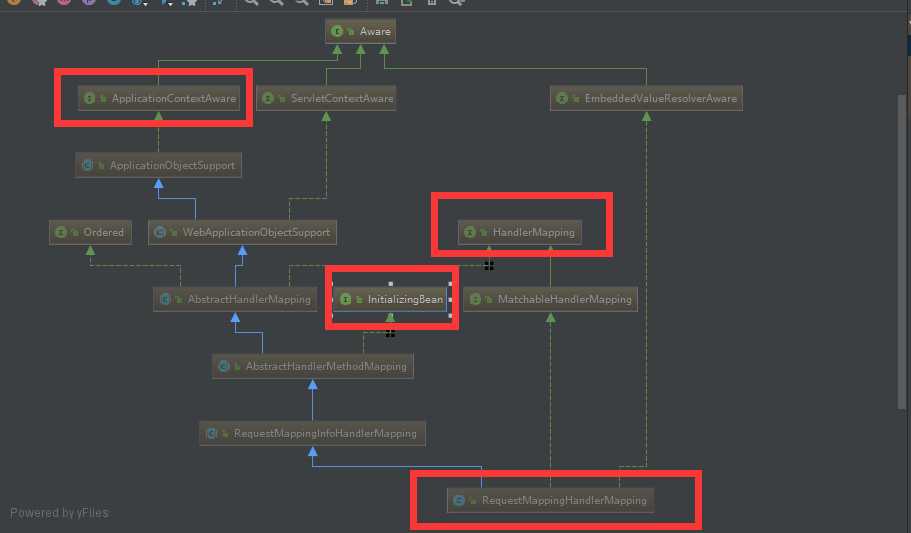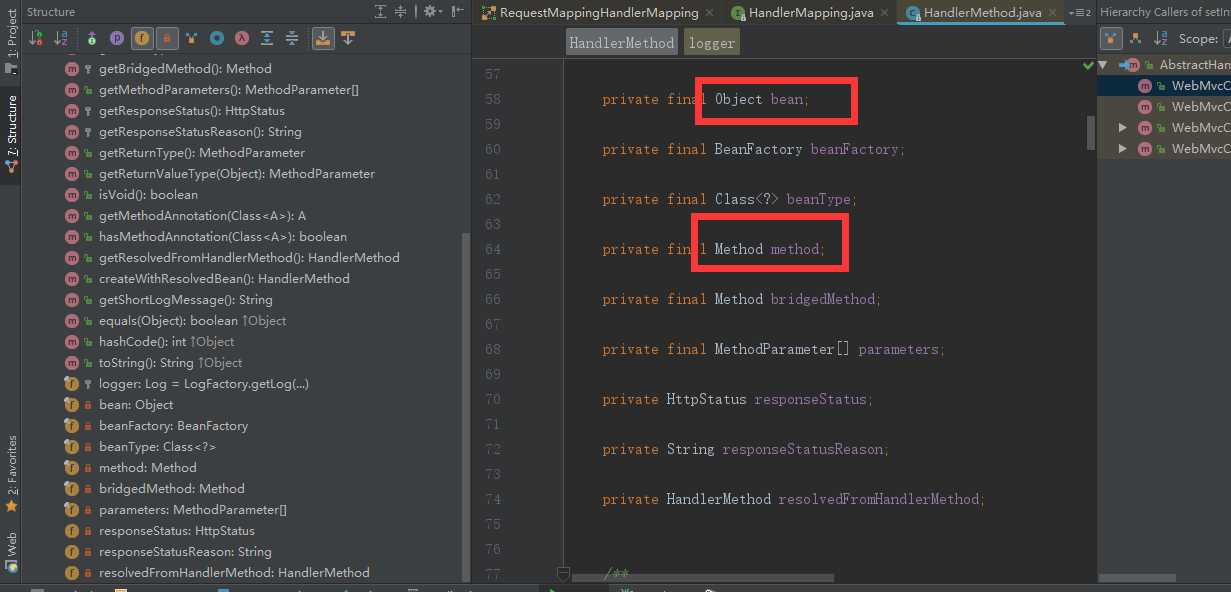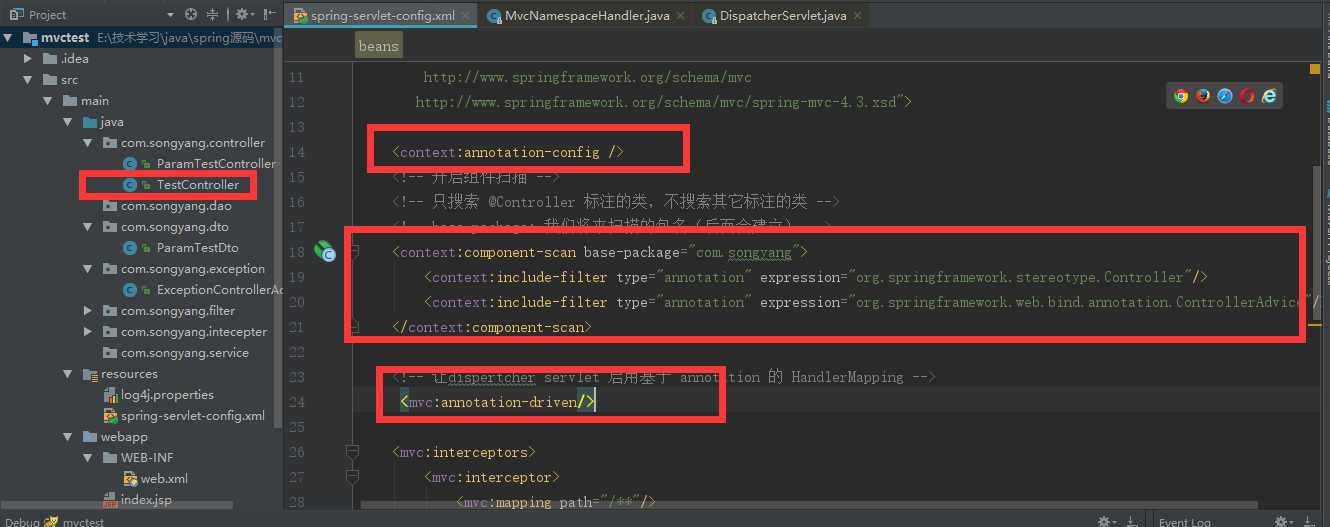标签:代码 oca tor tpm 继承 解析过程 chain nfa extension
前面我们简单地分析了两个过程,本文将会来介绍请求过来是如何找到对应的Controller中的方法的。
在分析之前,我们先记住几个类名,HandlerMapping接口,RequestMapingHandlerMapping类,HandlerMethod类。

关注一下,RequestMappingHandlerMapping的继承关系,几点说明一下

这里是HttpMethod的属性,本篇我们关注下bean和method两个属性,其它属性后面会谈到。
web.xml配置和之前的一样,这里不贴图了,看一下spring-servlet-config.xml的配置

看上图,context命名空间下的,我们不进行分析,关注<mvc:annotation-driven/>。分析事务、AOP时,我们知道了除了spring的基础命名空间外,其它标签的解析都是走parseCustomElement方法的。而对标签是解析是交给特点的解析器的。我们先在spring-webmvc的META-INF/spring.handlers方法找到MvcNamespaceHander,再在MvcNamespaceHandler找到AnnotationDrivenBeanDefinitionParser解析器。我们先看这个解析器的parse方法。
//AnnotationDrivenBeanDefinitionParser类的方法
//解析<mvc:annotation-driven/>,spring mvc的核心注解,有了它可以给我们注入映射器、适配器、异常处理器等等,这里我们关注映射器,而不用我们一个个<bean>标签地去配置了
public BeanDefinition parse(Element element, ParserContext parserContext) { ......
RootBeanDefinition handlerMappingDef = new RootBeanDefinition(RequestMappingHandlerMapping.class);
......
MvcNamespaceUtils.registerDefaultComponents(parserContext, source);
......
}
//MvcNamespaceUtils类的方法
//注册默认组件,这里我们关注下BeanNameUrlHandlerMapping的注册
public static void registerDefaultComponents(ParserContext parserContext, Object source) { registerBeanNameUrlHandlerMapping(parserContext, source); registerHttpRequestHandlerAdapter(parserContext, source); registerSimpleControllerHandlerAdapter(parserContext, source); }
//AbstractHandlerMethodMapping类的方法
//映射关系建立的入口
public void afterPropertiesSet() { initHandlerMethods(); }
//AbstactHandlerMethodMapping类的方法
//建立映射关系
protected void initHandlerMethods() { if (logger.isDebugEnabled()) { logger.debug("Looking for request mappings in application context: " + getApplicationContext()); } String[] beanNames = (this.detectHandlerMethodsInAncestorContexts ? BeanFactoryUtils.beanNamesForTypeIncludingAncestors(getApplicationContext(), Object.class) : getApplicationContext().getBeanNamesForType(Object.class)); for (String beanName : beanNames) { if (!beanName.startsWith(SCOPED_TARGET_NAME_PREFIX)) { Class<?> beanType = null; try { beanType = getApplicationContext().getType(beanName); } catch (Throwable ex) { // An unresolvable bean type, probably from a lazy bean - let‘s ignore it. if (logger.isDebugEnabled()) { logger.debug("Could not resolve target class for bean with name ‘" + beanName + "‘", ex); } } if (beanType != null && isHandler(beanType)) { detectHandlerMethods(beanName); } } } handlerMethodsInitialized(getHandlerMethods()); }
//RequestMappingHandlerMapping类的方法
//判断是否为handler
protected boolean isHandler(Class<?> beanType) { return (AnnotatedElementUtils.hasAnnotation(beanType, Controller.class) || AnnotatedElementUtils.hasAnnotation(beanType, RequestMapping.class)); }
//AbstractHandlerMethodMapping类的方法
//查找并注册带HandlerMethod
protected void detectHandlerMethods(final Object handler) { Class<?> handlerType = (handler instanceof String ? getApplicationContext().getType((String) handler) : handler.getClass()); final Class<?> userType = ClassUtils.getUserClass(handlerType); Map<Method, T> methods = MethodIntrospector.selectMethods(userType, new MethodIntrospector.MetadataLookup<T>() { @Override public T inspect(Method method) { try { return getMappingForMethod(method, userType); } catch (Throwable ex) { throw new IllegalStateException("Invalid mapping on handler class [" + userType.getName() + "]: " + method, ex); } } }); if (logger.isDebugEnabled()) { logger.debug(methods.size() + " request handler methods found on " + userType + ": " + methods); } for (Map.Entry<Method, T> entry : methods.entrySet()) { Method invocableMethod = AopUtils.selectInvocableMethod(entry.getKey(), userType); T mapping = entry.getValue(); registerHandlerMethod(handler, invocableMethod, mapping); } }
//MethodIntrospector类的方法
//遍历所有的方法,包括父类中的,匹配到的则注册到map中
public static <T> Map<Method, T> selectMethods(Class<?> targetType, final MetadataLookup<T> metadataLookup) { final Map<Method, T> methodMap = new LinkedHashMap<Method, T>(); Set<Class<?>> handlerTypes = new LinkedHashSet<Class<?>>(); Class<?> specificHandlerType = null; if (!Proxy.isProxyClass(targetType)) { handlerTypes.add(targetType); specificHandlerType = targetType; } handlerTypes.addAll(Arrays.asList(targetType.getInterfaces())); for (Class<?> currentHandlerType : handlerTypes) { final Class<?> targetClass = (specificHandlerType != null ? specificHandlerType : currentHandlerType); ReflectionUtils.doWithMethods(currentHandlerType, new ReflectionUtils.MethodCallback() { @Override public void doWith(Method method) { Method specificMethod = ClassUtils.getMostSpecificMethod(method, targetClass); T result = metadataLookup.inspect(specificMethod); if (result != null) { Method bridgedMethod = BridgeMethodResolver.findBridgedMethod(specificMethod); if (bridgedMethod == specificMethod || metadataLookup.inspect(bridgedMethod) == null) { methodMap.put(specificMethod, result); } } } }, ReflectionUtils.USER_DECLARED_METHODS); } return methodMap; }
//RequestMappingHandlerMapping类的方法
//判断是否有@RequestMapping注解
private RequestMappingInfo createRequestMappingInfo(AnnotatedElement element) { RequestMapping requestMapping = AnnotatedElementUtils.findMergedAnnotation(element, RequestMapping.class); RequestCondition<?> condition = (element instanceof Class ? getCustomTypeCondition((Class<?>) element) : getCustomMethodCondition((Method) element)); return (requestMapping != null ? createRequestMappingInfo(requestMapping, condition) : null); }
//RequestMappingHandlerMapping类的方法
//这里就是把@RequestMappingHandlerMapping中的信息封装到RequestMappingInfo对象中
protected RequestMappingInfo createRequestMappingInfo( RequestMapping requestMapping, RequestCondition<?> customCondition) { return RequestMappingInfo .paths(resolveEmbeddedValuesInPatterns(requestMapping.path())) .methods(requestMapping.method()) .params(requestMapping.params()) .headers(requestMapping.headers()) .consumes(requestMapping.consumes()) .produces(requestMapping.produces()) .mappingName(requestMapping.name()) .customCondition(customCondition) .options(this.config) .build(); }
public RequestMappingInfo build() {
ContentNegotiationManager manager = this.options.getContentNegotiationManager();
PatternsRequestCondition patternsCondition = new PatternsRequestCondition(
this.paths, this.options.getUrlPathHelper(), this.options.getPathMatcher(),
this.options.useSuffixPatternMatch(), this.options.useTrailingSlashMatch(),
this.options.getFileExtensions());
return new RequestMappingInfo(this.mappingName, patternsCondition,
new RequestMethodsRequestCondition(methods),
new ParamsRequestCondition(this.params),
new HeadersRequestCondition(this.headers),
new ConsumesRequestCondition(this.consumes, this.headers),
new ProducesRequestCondition(this.produces, this.headers, manager),
this.customCondition);
}
到这里所有的映射关系都建立好的,通过url就可以找到maping信息,通过mapping信息就对找到handlerMethod、mappingRegistration等所有所有信息了。接下来,我们就来看调用过程。
//AbstractHandlerMethodMapping类的方法
//注册处理器方法
protected void registerHandlerMethod(Object handler, Method method, T mapping) { this.mappingRegistry.register(mapping, handler, method); }
//AbstractHandlerMethodMapping的内部类
//映射关系都是注册在这个类上的
public void register(T mapping, Object handler, Method method) { this.readWriteLock.writeLock().lock(); try { HandlerMethod handlerMethod = createHandlerMethod(handler, method); assertUniqueMethodMapping(handlerMethod, mapping); if (logger.isInfoEnabled()) { logger.info("Mapped \"" + mapping + "\" onto " + handlerMethod); } this.mappingLookup.put(mapping, handlerMethod); List<String> directUrls = getDirectUrls(mapping); for (String url : directUrls) { this.urlLookup.add(url, mapping); } String name = null; if (getNamingStrategy() != null) { name = getNamingStrategy().getName(handlerMethod, mapping); addMappingName(name, handlerMethod); } CorsConfiguration corsConfig = initCorsConfiguration(handler, method, mapping); if (corsConfig != null) { this.corsLookup.put(handlerMethod, corsConfig); } this.registry.put(mapping, new MappingRegistration<T>(mapping, handlerMethod, directUrls, name)); } finally { this.readWriteLock.writeLock().unlock(); } }
//DispatcherServlet类方法
//请求调用过程
protected void doDispatch(HttpServletRequest request, HttpServletResponse response) throws Exception { ...... HandlerExecutionChain mappedHandler = null; ...... mappedHandler = getHandler(processedRequest); ....... }
//HandlerExecutionChain的属性
private final Object handler; private HandlerInterceptor[] interceptors; private List<HandlerInterceptor> interceptorList;
//DispatcherServlet类的方法
//获取处理器链
protected HandlerExecutionChain getHandler(HttpServletRequest request) throws Exception { for (HandlerMapping hm : this.handlerMappings) { if (logger.isTraceEnabled()) { logger.trace( "Testing handler map [" + hm + "] in DispatcherServlet with name ‘" + getServletName() + "‘"); } HandlerExecutionChain handler = hm.getHandler(request); if (handler != null) { return handler; } } return null; }
//RequestMappingHandlerMapping的父类AbstractHandlerMapping的方法
//查找handler和拦截器,形成处理链
public final HandlerExecutionChain getHandler(HttpServletRequest request) throws Exception { Object handler = getHandlerInternal(request); if (handler == null) { handler = getDefaultHandler(); } if (handler == null) { return null; } // Bean name or resolved handler? if (handler instanceof String) { String handlerName = (String) handler; handler = getApplicationContext().getBean(handlerName); } HandlerExecutionChain executionChain = getHandlerExecutionChain(handler, request); if (CorsUtils.isCorsRequest(request)) { CorsConfiguration globalConfig = this.corsConfigSource.getCorsConfiguration(request); CorsConfiguration handlerConfig = getCorsConfiguration(handler, request); CorsConfiguration config = (globalConfig != null ? globalConfig.combine(handlerConfig) : handlerConfig); executionChain = getCorsHandlerExecutionChain(request, executionChain, config); } return executionChain; }
//AbstractHandlerMethodMapping类的方法
//根据请求获取合适的HandlerMethod对象
protected HandlerMethod getHandlerInternal(HttpServletRequest request) throws Exception { String lookupPath = getUrlPathHelper().getLookupPathForRequest(request); if (logger.isDebugEnabled()) { logger.debug("Looking up handler method for path " + lookupPath); } this.mappingRegistry.acquireReadLock(); try { HandlerMethod handlerMethod = lookupHandlerMethod(lookupPath, request); if (logger.isDebugEnabled()) { if (handlerMethod != null) { logger.debug("Returning handler method [" + handlerMethod + "]"); } else { logger.debug("Did not find handler method for [" + lookupPath + "]"); } } return (handlerMethod != null ? handlerMethod.createWithResolvedBean() : null); } finally { this.mappingRegistry.releaseReadLock(); } }
//AbstractHandlerMethodMapping类的方法
//根据url获取合适的HandlerMethod对象
protected HandlerMethod lookupHandlerMethod(String lookupPath, HttpServletRequest request) throws Exception {
List<Match> matches = new ArrayList<Match>();
List<T> directPathMatches = this.mappingRegistry.getMappingsByUrl(lookupPath);
if (directPathMatches != null) {
addMatchingMappings(directPathMatches, matches, request);
}
if (matches.isEmpty()) {
// No choice but to go through all mappings...
addMatchingMappings(this.mappingRegistry.getMappings().keySet(), matches, request);
}
if (!matches.isEmpty()) {
Comparator<Match> comparator = new MatchComparator(getMappingComparator(request));
Collections.sort(matches, comparator);
if (logger.isTraceEnabled()) {
logger.trace("Found " + matches.size() + " matching mapping(s) for [" +
lookupPath + "] : " + matches);
}
Match bestMatch = matches.get(0);
if (matches.size() > 1) {
if (CorsUtils.isPreFlightRequest(request)) {
return PREFLIGHT_AMBIGUOUS_MATCH;
}
Match secondBestMatch = matches.get(1);
if (comparator.compare(bestMatch, secondBestMatch) == 0) {
Method m1 = bestMatch.handlerMethod.getMethod();
Method m2 = secondBestMatch.handlerMethod.getMethod();
throw new IllegalStateException("Ambiguous handler methods mapped for HTTP path ‘" +
request.getRequestURL() + "‘: {" + m1 + ", " + m2 + "}");
}
}
handleMatch(bestMatch.mapping, lookupPath, request);
return bestMatch.handlerMethod;
}
else {
return handleNoMatch(this.mappingRegistry.getMappings().keySet(), lookupPath, request);
}
}
public List<T> getMappingsByUrl(String urlPath) {
return this.urlLookup.get(urlPath);
}
整个流程还是比较清楚的,解析标签<mvc:annotation-driven/>、实例化RequestMappingHandlerMapping时会建立映射关系、请求时查找映射关系。接下来会接着对拦截器进行分析
标签:代码 oca tor tpm 继承 解析过程 chain nfa extension
原文地址:https://www.cnblogs.com/lucas2/p/9425044.html